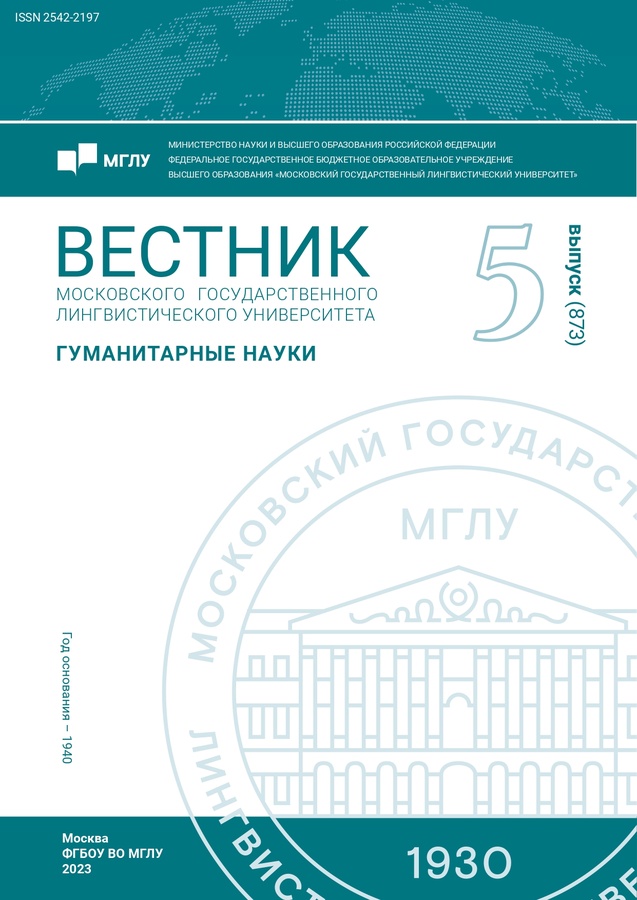Linguistic and Cultural Polyphony of the Megapolis in Life and on the Screen (BBC TV Series EastEnders)
- Авторлар: Kazak E.A.1
-
Мекемелер:
- Institute of Scientific Information for Social Sciences of the Russian Academy of Sciences
- Шығарылым: № 5(873) (2023)
- Беттер: 53-59
- Бөлім: Linguistics
- URL: https://journal-vniispk.ru/2542-2197/article/view/351347
- ID: 351347
Дәйексөз келтіру
Толық мәтін
Аннотация
We study the language situation in London which similar to many other big cities in Europe is now home to immigrants from different countries. As a result of this process the English language spoken in London has changed rapidly. The traditional dialect Cockney has been replaced by Multicultural London English which has emerged in multiethnic inner city boroughs in London.
Негізгі сөздер
Авторлар туралы
Evgeniya Kazak
Institute of Scientific Information for Social Sciences of the Russian Academy of Sciences
Хат алмасуға жауапты Автор.
Email: ladykazak@gmail.com
PhD (Philology), Research Fellow of Linguistics Department
РесейӘдебиет тізімі
- Wiese, H. (2009). Grammatical innovations in multiethnic urban Europe: new linguistic practices among adolescents. Lingua, 119, 782–806.
- Cheshire, J., Fox, S. (2009). Was/were variation: A perspective from London. Language Variation and Change, 21(1), 1–38.
- Svenden, B., Royneland, U. (2008). Multiethnical facts and functions in Oslo, Norway. International Journal of Bilingualism, 12(1&2), 63–83.
- Quist, P. (2008). Sociolinguistic approach to multiethnolect: Language variety and stylistic practice. International Journal of Bilingualism, 12(1&2), 43–61.
- King, L., Carson, L. (Eds.) (2016). The multilingual city vitality, conflict and change. Bristol: Multilingual matters.
- Butler, T., Hamnett, C. (2011). Ethnicity, class and aspiration: Understanding London’s new East End. Bristol: Policy press.
- Gardner, K., Shukur, A. (1995). I’m Bengali, I’m Asian and I’m living here. The Changing identity of British Bengalis. In Ballard, R. (ed.), Desh Pradesh. The South Asian Presence in Britain (pp. 213–235). London: Hurst company.
- Kotin, I. Ju. (2003). Pobegi ban’jana: Migracija naselenija iz Indji i formirovanie “uzlov” juzhno-aziatskoj diaspory = Banyan shoots: Migration from India and the formation of “clusters” of South Asian diaspora. St.Petersburg: Peterburgskoe vostokovedenie. (In Russ.)
- Merenkova, O. N. (2011). "The "British Bangladeshi" in search of identity". Etnograficheskoe obozrenie, 5, 109–117. (In Russ.)
- Fox, S. (2015). The new Cockney: New ethnicities and adolescent speech in the traditional East End of London. Basingstoke: Palgrave Macmillan.
- Cole, A. (2020). Identifications of speaker ethnicity in South-East England: Multicultural London English as a divisible perceptual variety. In Proceedings of the LREC 2020. Workshop on “Citizen Linguistics in language resource development” (pp. 49–57).
- Kerswill, P. (2014). The objectification of “Jafaican”: The discoursal embedding of multicultural London English in the British media. In Mediatization and Sociolinguistic change (pp. 428–455). Berlin.
- Mount, H. (2010). Word on the street in London. https. standard.co.uk/lifestyle/word-on-the-street-in-london-6487089.html.
- Kotin, I. Ju. (2013). To be British, to be Asian? The dilemma of the British Asians as seen by Daljit Nagra. Vestnik of Saint Petersburg University, 13(4), 94–107. (In Russ.)
- Stuart-Smith, J., Pryce, Gw., Timmins, C., Gunter, B. (2013). Television can also be a factor in language change: Evidence from an urban dialect. Language, 89(3), 501–536.
- Onishenko, Ju. V. (2018). Social’no obuslovlennaja priroda britanskogo telediskursa kak sposoba formirovanija jazykovoj i mental’noj dejstvitel’nosti nacii = The socially conditioned nature of the British TV discourse as a way of forming the linguistic and mental reality of the nation. In Inostrannaja filologija. Social’naja i nacional’naja variativnost’ jazyka i literatury (pp. 147–153): III International Scientific Congress Proceedings. Simferopol. (In Russ.)
Қосымша файлдар










